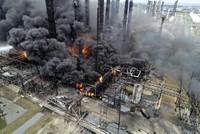Advertisement
Grab your lab coat. Let's get started
Welcome!
Welcome!
Create an account below to get 6 C&EN articles per month, receive newsletters and more - all free.
It seems this is your first time logging in online. Please enter the following information to continue.
As an ACS member you automatically get access to this site. All we need is few more details to create your reading experience.
Not you? Sign in with a different account.
Not you? Sign in with a different account.
ERROR 1
ERROR 1
ERROR 2
ERROR 2
ERROR 2
ERROR 2
ERROR 2
Password and Confirm password must match.
If you have an ACS member number, please enter it here so we can link this account to your membership. (optional)
ERROR 2
ACS values your privacy. By submitting your information, you are gaining access to C&EN and subscribing to our weekly newsletter. We use the information you provide to make your reading experience better, and we will never sell your data to third party members.
Safety
2015 ExxonMobil Blast Dodged Catastrophe
by Jeff Johnson
January 25, 2016
| A version of this story appeared in
Volume 94, Issue 4
Multiple process safety management errors led to a potentially calamitous accident at a Southern California ExxonMobil refinery last February, the U.S. Chemical Safety & Hazard Investigation Board (CSB) found in a preliminary report. Two workers were injured when leaking hydrocarbons exploded in an electrostatic precipitator, part of the facility’s air pollution control systems, said CSB Chair Vanessa Allen Sutherland. She presented CSB findings earlier this month at a meeting in Torrance, Calif., where the refinery is located. The accident could have been much worse, she said. The explosion sent debris flying, and one piece narrowly missed a tank containing thousands of kilograms of hydrofluoric acid. Had the debris hit the tank, Sutherland said, it could have ruptured, resulting in a catastrophic release of extremely toxic HF into the neighboring community of 33,000. “After HF acid vaporizes,” Sutherland explained, “it condenses into small droplets that form a dense low-lying cloud that will travel along the ground for miles, causing severe damage to respiratory systems, skin, and bones of those who are exposed, potentially resulting in death.”



Join the conversation
Contact the reporter
Submit a Letter to the Editor for publication
Engage with us on Twitter